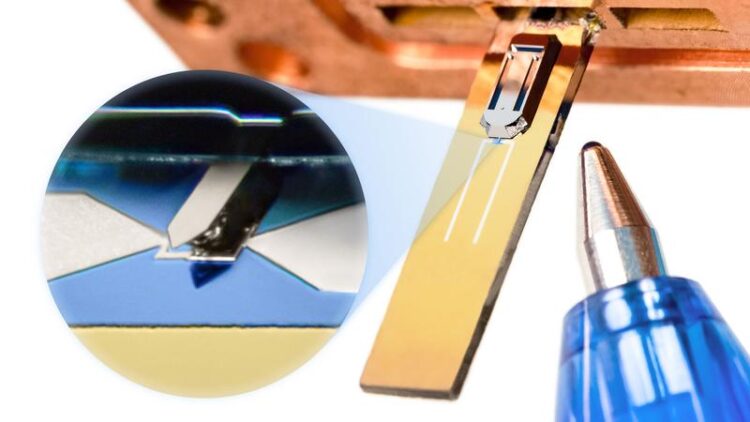Blast Chiller for the Quantum World

Superconducting circuit (white) on a silicon substrate fixed in a copper holder. The chip (silver) with the micromechanical oscillator is attached to the silicon substrate.
Credit: IQOQI Innsbruck
The quantum nature of objects visible to the naked eye is currently a much-discussed research question. A team led by Innsbruck physicist Gerhard Kirchmair has now demonstrated a new method in the laboratory that could make the quantum properties of macroscopic objects more accessible than before. With the method, the researchers were able to increase the efficiency of an established cooling method by an order of a magnitude.
With optomechanical experiments, scientists are trying to explore the limits of the quantum world and to create a foundation for the development of highly sensitive quantum sensors. In these experiments, objects visible to the naked eye are coupled to superconducting circuits via electromagnetic fields. To get functioning superconductors, such experiments take place in cryostats at a temperature of about 100 millikelvin. But this is still far from sufficient to really dive into the quantum world. In order to observe quantum effects on macroscopic objects, they must be cooled to nearly absolute zero using sophisticated cooling methods. Physicists led by Gerhard Kirchmair from the Department of Experimental Physics at the University of Innsbruck and the Institute of Quantum Optics and Quantum Information (IQOQI) have now demonstrated a nonlinear cooling mechanism with which even massive objects can be cooled well.
Cooling capacity higher than common
In the experiment, the Innsbruck researchers couple the mechanical object – in their case a vibrating beam – to the superconducting circuit via a magnetic field. To do this, they attached a magnet to the beam, which is about 100 micrometers long. When the magnet moves, it changes the magnetic flux through the circuit, the heart of which is a so-called SQUID, a superconducting quantum interference device. Its resonant frequency changes depending on the magnetic flux, which is measured using microwave signals. In this way, the micromechanical oscillator can be cooled to near the quantum mechanical ground state. Furthermore, David Zöpfl from Gerhard Kirchmair’s team explains, “The change in the resonant frequency of the SQUID circuit as a function of microwave power is not linear. As a consequence, we can cool the massive object by an order of magnitude more for the same power.” This new, simple method is particularly interesting for cooling more massive mechanical objects. Zöpfl and Kirchmair are confident that this could be the foundation for the search of quantum properties in larger macroscopic objects.
The work was carried out in collaboration with scientists in Canada and Germany and has now been published in Physical Review Letters. The research was financially supported by the Austrian Science Fund FWF and the European Union, among others. Co-authors Christian Schneider and Lukas Deeg are or were members of the FWF Doctoral Program Atoms, Light and Molecules (DK-ALM).
Wissenschaftliche Ansprechpartner:
Gerhard Kirchmair
Department of Experimental Physics
University of Innsbruck
p +43 512 507 4736
e Gerhard.Kirchmair@uibk.ac.at
w https://iqoqi.at/_groups/en/group-page-kirchmair
Originalpublikation:
Kerr Enhanced Backaction Cooling in Magnetomechanics. D. Zoepfl, M. L. Juan, N. Diaz-Naufal, C. M. F. Schneider, L. F. Deeg, A. Sharafiev, A. Metelmann, and G. Kirchmair. Phys. Rev. Lett. 130, 033601 DOI: https://doi.org/10.1103/PhysRevLett.130.033601
Media Contact
All latest news from the category: Physics and Astronomy
This area deals with the fundamental laws and building blocks of nature and how they interact, the properties and the behavior of matter, and research into space and time and their structures.
innovations-report provides in-depth reports and articles on subjects such as astrophysics, laser technologies, nuclear, quantum, particle and solid-state physics, nanotechnologies, planetary research and findings (Mars, Venus) and developments related to the Hubble Telescope.
Newest articles

First-of-its-kind study uses remote sensing to monitor plastic debris in rivers and lakes
Remote sensing creates a cost-effective solution to monitoring plastic pollution. A first-of-its-kind study from researchers at the University of Minnesota Twin Cities shows how remote sensing can help monitor and…

Laser-based artificial neuron mimics nerve cell functions at lightning speed
With a processing speed a billion times faster than nature, chip-based laser neuron could help advance AI tasks such as pattern recognition and sequence prediction. Researchers have developed a laser-based…

Optimising the processing of plastic waste
Just one look in the yellow bin reveals a colourful jumble of different types of plastic. However, the purer and more uniform plastic waste is, the easier it is to…


